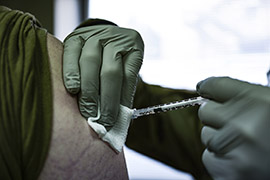- Slug: BC-CNS-COVID Normal,670 words.
- 2 photos, video story available. (thumbnails, captions below)
By Alexandria Cullen
Cronkite News
WASHINGTON – The U.S. has entered a “new normal” for COVID-19, with lower but consistent levels of infection. But experts fear that the new normal may include people skipping vaccines that are still needed for protection.
“So few people are getting this new booster that is specifically targeting the new circulating strains of the Omicron virus,” said Will Humble, executive director of the Arizona Public Health Association.
The Arizona Department of Health Services no longer posts regular updates of vaccination rates, but the Centers for Disease Control and Prevention said that just 17% of Arizona residents were up to date with their COVID-19 vaccinations as of Sept. 12, the most recent date for which numbers were available.
Arizona was about in the middle of states when it came to being up to date on boosters, with rates ranging from 3.7% in Texas to 35.4% in Vermont.
It comes as the rate of COVID-19 infections is seeing a seasonal surge, but cases are a mere fraction of the highs seen during the pandemic.
For the week of Nov. 26, the most recent date for which it has numbers, ADHS reported 3,627 confirmed coronavirus cases in Arizona. That compares to 44,974 cases reported at roughly the time three years ago, and the current numbers are dwarfed by the 157,540 cases reported in the first week of 2022, the peak of the pandemic.
“We are very well below the three-year average at a … 74% decrease,” said Siman Qaasim, the ADHS assistant director of policy and intergovernmental affairs.
Deaths are falling as well. The CDC reported just 438 COVID-19 deaths nationwide in the week preceding Nov. 25, and just 12 for that week in Arizona. Those compare to 25,974 nationally and 971 in Arizona during the worst week of the pandemic.
But with all those numbers down, the possibility that cases may begin to rise becomes more likely, due to the lack of updated vaccinations. Humble attributes the low vaccination to several reasons, including that it’s “just human psychology.”
“Part of it is political,” Humble said, noting that people are not as reluctant to roll up their sleeves for a seasonal flu shot. “Part of it is just, people are in the habit of getting the influenza vaccine. It’s more familiar to them over the course of even decades.”
Dr. Georges Benjamin, executive director at the American Public Health Association, says those factors can be described as “COVID fatigue.”
“If history tells us anything … you do tend to have a fall-off, as people begin to see, at least currently, the disease is not as deadly as it has been in the past,” Benjamin said.
He and other health care professionals say that is a mistake.
“I think the best medical advice that we can give people for their health is to go ahead and get fully vaccinated based on the current recommendations,” Benjamin said.
The latest vaccines, from pharmaceutical companies Moderna, Pfizer-BioNTech and Novavax, target XBB.1.5, a version of the omicron variant of the coronavirus that has been present since November 2021. The CDC said the updated vaccines should also work against currently circulating variants of the virus—many of which descended from, or are related to, the XBB strain.
Health care professionals say the best protection is getting vaccinated, but that there are additional ways to halt the spread of the disease.
“Of course, staying at home when you’re sick to protect others, to protect people who are vulnerable older Arizonans as well as those who may have a condition,” Qaasim said.
With the holiday season underway, experts say the uptick in travel and people gathering could potentially lead to a rise as well.
“The social mixing that happens in the holiday season amplifies the virus,” Humble said. “The more people are in closed, indoor environments… Those are great environments to spread both influenza and COVID-19.”
But there’s an easy way to keep from doing that while still enjoying the holidays, Humble said.
“It couldn’t be any simpler, just get the vaccines,” he said. “That’s it.”
For more stories from Cronkite News, visit cronkitenews.azpbs.org.
^__=
Web links:
_ ADHS data: https://www.azdhs.gov/covid19/data/index.php
_ CDC vaccinations data: https://covid.cdc.gov/covid-data-tracker/#vaccination-states-jurisdictions
_ CDC vaccinations data: https://covid.cdc.gov/covid-data-tracker/#trends_weeklydeaths_weeklyhospitaladmissions100k_00
_ Updated vaccines: https://www.fda.gov/news-events/press-announcements/fda-takes-action-updated-mrna-covid-19-vaccines-better-protect-against-currently-circulating
^__=
COVID-19 cases have fallen sharply from pandemic highs, but it still remains, and health officials worry that may not be keeping their vaccinations up to date to fight the latest variants. An Air Force Reservist gets a dose of COVID-19 vaccine in Pittsburgh in this Feb. 4, 2021, photo. (Photo by Joshua J. Seybert/U.S. Air Force)
Health officials worry that not enough Americans are keeping their COVID-19 vaccinations up to date with vaccines targeting the newest strains of the virus. A Air Force Reservist holds up a first-generation vial of Moderna COVID-19 vaccine in this Feb. 4, 2021, photo. (Photo by Joshua J. Seybert/U.S. Air Force)

